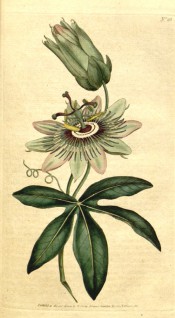Passiflora caerulea L.
Frost-hardy, fast-growing, often rampant, climber with slender stems, deeply, 3-9-lobed leaves, to 10cm long, and bowl-shaped, white or pink-tinged flowers in summer and autumn, to 10cm across, with purple-, blue- and white-zoned coronas, followed by edible orange-yellow fruit, to 6cm long. To 10m or more. [RHSE, Hortus, Hilliers’].
Horticultural & Botanical History
‘The Passion-Flower first introduced into this country, was the incarnata of Linnaeus, a native of Virginia, and figured by Parkinson, in his Paradisus Terrestris, who there styles it the surpassing delight of all flowers: the present species, which, from its great beauty and superior hardiness, is now by far the most common, is of more modern introduction; and, though a native of the Brazils, seldom suffers from the severity of our climate; flowering plentifully during most of the summer months, if trained to a wall with a southern aspect, and, in such situations, frequently producing ripe fruit, of the size and form of a large olive, of a pale orange colour.’ [BM t.28/1787]. Introduced to Europe in 1699. [PD]. BR f.488/1820.
History at Camden Park
Listed in all published catalogues [T.720/1843]. Passiflora caerulea was ticked in a copy of the Hort. Reg., October 1831. Although this originally belonged to James Bowman, it is likely that this plant was grown by Macarthur earlier than 1843.
Notes
Occasionally seen as a garden escape in the Sydney region [FNSW, Beadle] and often used as rootstock for tenderer varieties.
Published Jan 31, 2010 - 01:18 PM | Last updated Jul 29, 2010 - 02:06 PM
| Family | Passifloraceae |
|---|---|
| Category | |
| Region of origin | Central and South America |
| Synonyms | |
| Common Name | Blue passionflower |
| Name in the Camden Park Record |
Passiflora caerulea |
| Confidence level | high |


